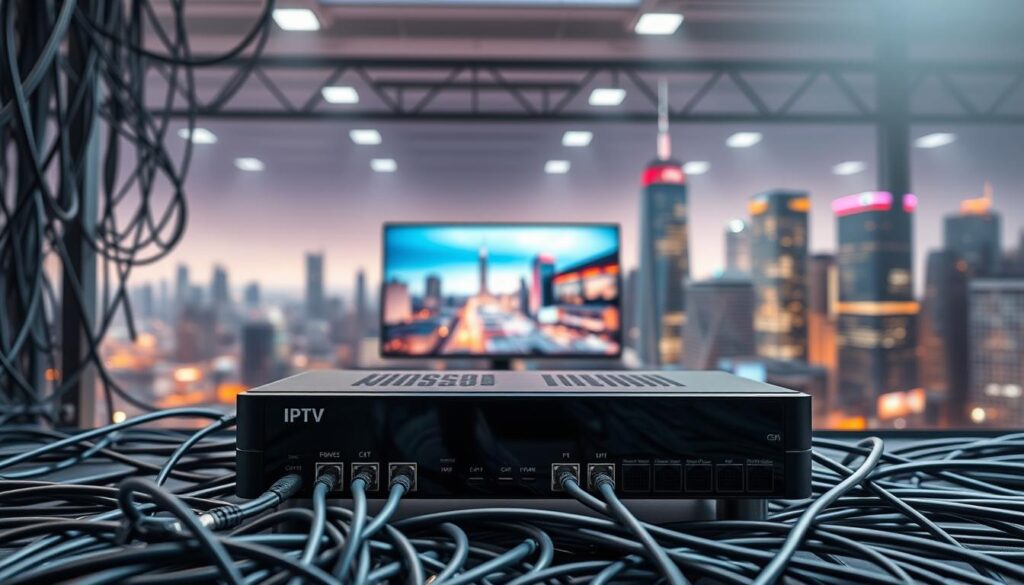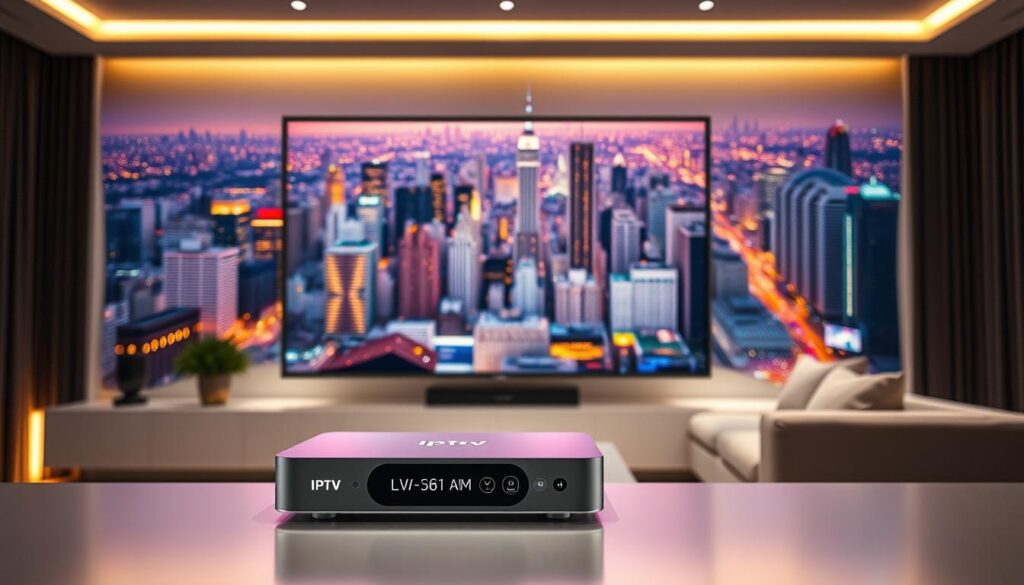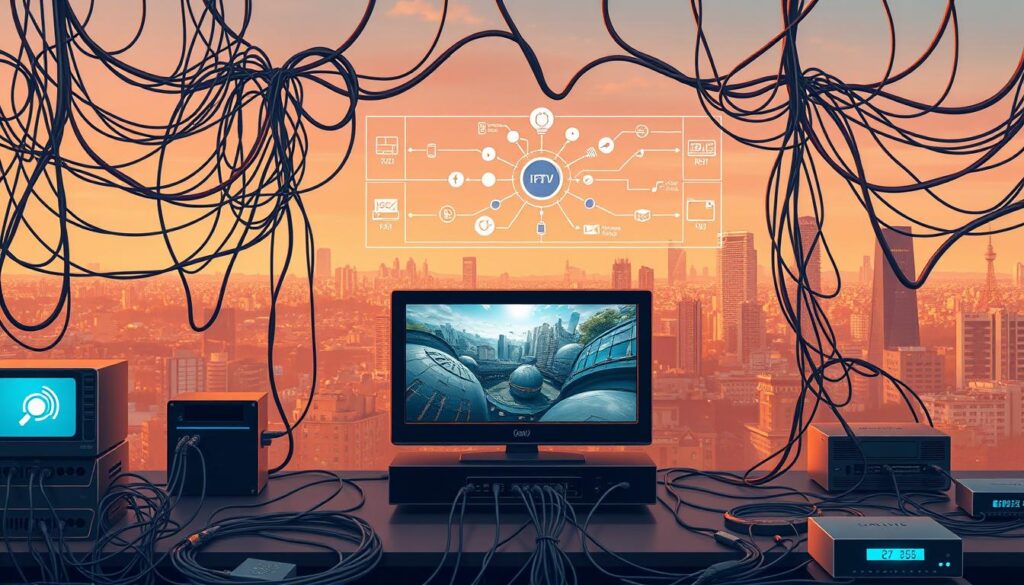Introduction
From the advent of computers and mobile devices, the world of entertainment has had remarkable improvements in multiple ways. (How Does IPTV Work) One of the most advanced methods is the Internet Protocol Television (IPTV). Unlike traditional cable television or satellite services, IPTV sends programming over the Internet. But how does IPTV work? What happens when you click the “play” button on your favorite show?

In this article, we provide an in-depth examination of the technology, its types, advantages, and challenges to better assist you understand how it works and everything else there is to know.
In short, IPTV is a system where television service is provided through the Internet Protocol as opposed to satellite signals, or cable. A broadband connection streams the content to your device in real time or pre-records it.
This method allows users greater customization and a tailored experience. Users are no longer restricted to scheduled viewing as they have the option to tune in at any time.
So, as we mentioned above, TV, but smarter, faster, and more adaptable.
Understanding how IPTVs work
The basic framework of IPTVs function is rather simple, yet innovative:
Acquiring Content
Initially, service providers focus on obtaining content which can be live TV, Movies, series, and even sports. Service IP providers can negotiate and purchase rights to content, or content can be produced in-house.
Preparing content
Steps such as moderating content before delivering it raw, encoding it in formats such as MPEG-4 and H.264, digitally compressing it to save space, and even on occasion encrypting it to protect ownership claim, are all done prior to content going online.
Storing Contents
Content is kept in servers. Live broadcasts are streamed on real-time while video on demand content is stored in data bases. Episodes of the show, movies can be accessed whenever the user chooses from VOD.
Delivering Content
Once a user selects a given program, the IPTV server fetches the video from themselves servers and send it directly the users. The streaming method defines the ability to play files without full download requirements.
User Interface and Playback:
IPTV (Internet Protocol television) applications and systems offer the user interface (UI) — menus, channel lists, and search options. Users engage with this interface to navigate, choose, and view content on devices, including smart televisions, smartphones, tablets and computers.
Key Technologies behind IPTV
A number of critical technologies facilitate the functioning of IPTV:

Internet Protocol (IP): The foundational technology responsible for transmitting data packets across various interfaces, including video streaming.
Streaming Servers: Advanced technology that supplies streams to users in real-time while ensuring reduced latency.
Content Delivery Networks (CDNs): Server network that improves retrieval speed and minimizes buffering by ensuring users receive the content from the geographically closest server.
Middleware: Software linking the user’s device with the IPTV server, controlling user-subscription, billing, video playing, and parental controls interactions.
Set Top Boxes (optional): Users with older television sets that lack smart features may need a decoder (like an Android box or MAG box) that interface with the IPTV signal.
Types of IPTV Services
There are different types of IPTV services to cater to different user requirements:
1. Live TV
Live IPTV allows broadcasting of channels in real-time. Users can view news, sports or events as they happen like with satellite and cable TV.
2. Video on Demand (VOD)
VOD services let users select and watch content at their preferred time. Examples Netflix, Amazon Prime Video Online, Disney+ are world-famous today.
3. Time-Shifted TV
Time-shifted IPTV offers time-shifted viewing of previously aired shows. It includes catch-up TV services as well as DVR functionality that allows you to pause, rewind or replay live television shows.
4. Near Video on Demand (nVOD)
nVOD services broadcast programs over multiple channels and spaced apart by time slots.This enables users to select options and reduces waiting time before the show starts.
Devices That Support IPTV.
IPTV is far more flexible than its competitors. IPTV devices can be used to view content.
Smart TVs (Samsung, LG, Sony)
Streaming gadgets (Roku, Amazon Fire Stick, Apple TV, Chromecast)
Laptops and Desktops (via web browsers and dedicated applications)
Tablets and smartphones (apps on IOS and Android)
Android TV boxes (set-top boxes for non-smart TVs)
If a device can connect to the internet and video streaming, it is suitable for IPTV.
Advantages of IPTV
Internet Protocol Television offers several advantages when compared to traditional television services:
Flexibility: Stream anything on the device you prefer.
More Variety: Content from across the world, obscure channels, and specialized programming are not easier to obtain but also easier to access.
Cable and satellite subscriptions are offered at a lower price than IPTV services.
Interactive Features: Includes pause, rewind, fast forward, and program recording, as well as multitasking capabilities like access to supplementary program information.
Personalization: Formulate playlists, specify preferred content, and customize recommendations tailored to user’s viewing history.
Challenges and Limitations of IPTV
Although IPTV has several benefits, it comes with these challenges:
Internet Dependence: Requires stable high-speed internet connection. Slow connectivity results in buffering, low-quality video, and poor streaming experiences.
Service Quality: Not all IPTV providers offer reliable service. Some might have frequent downtimes and inconsistencies in their service.
Legality Issues: There are several unauthorized IPTV services that operate illegally and provide pirated content without permission. It is important for users to be careful in where the draw the line legally.
Geographical Restrictions: Certain content comes with region-locks requiring VPNs or specific subscriptions to predetermined locations.
Device Compatibility: Most modern devices are compatible with IPTV, but some older hardware may have problems with newer streaming protocols.
The Future of IPTV
Broadband access and increased internet speeds are set to revolutionize television consumption.

The advancement of technologies such as 5G, fiber optic internet, AI for content suggestion, and cloud streaming will serve to further enhance the service making it faster, more intuitive, and more personalized.
In the face of competition, cable and satellite operators are already merging to offer their proprietary IPTV systems, suggesting a critical shift in the industry towards internet television services.
As a result
The industry is facing a new paradigm shift – a more fundamental and accessible way to consume TV content, thanks to the rise of flexible and lower-priced IPTV services. Its backbone is delivering television signals through the internet, integrating powerful servers, content management systems, and intuitive interfaces to usher television into the modern era through broadband connections.
The future of entertainment is in your hands as long as you have a trustworthy ISP, a stable connection, and a solid provider – IPTV opens limitless possibilities.
IPTV is revolutionizing the television industry, whether it’s for watching international channels, binge-watching a new series, or broadcasting live sports events.
